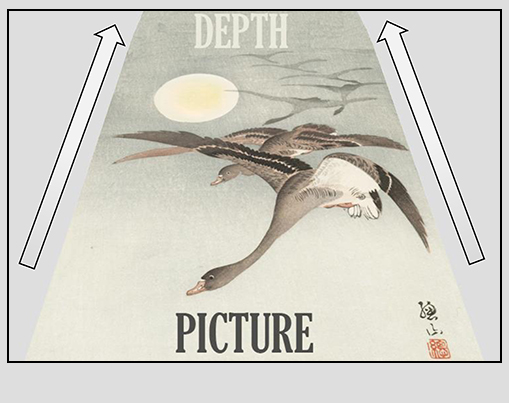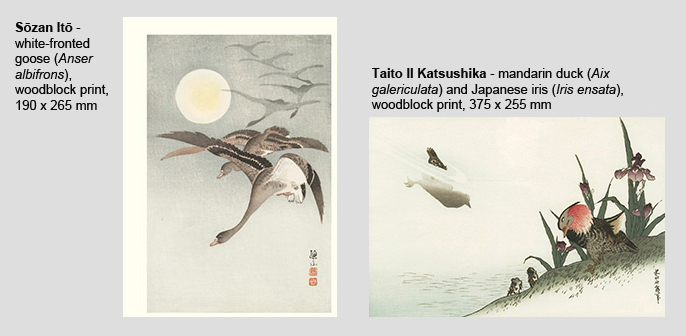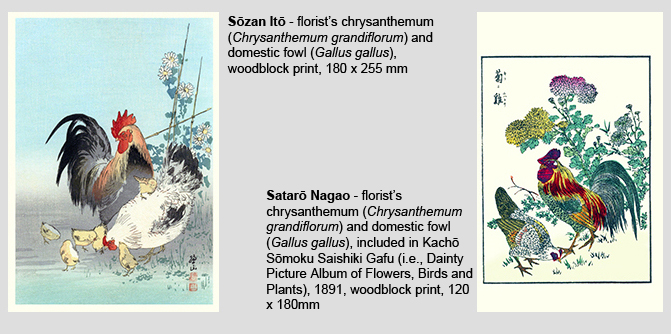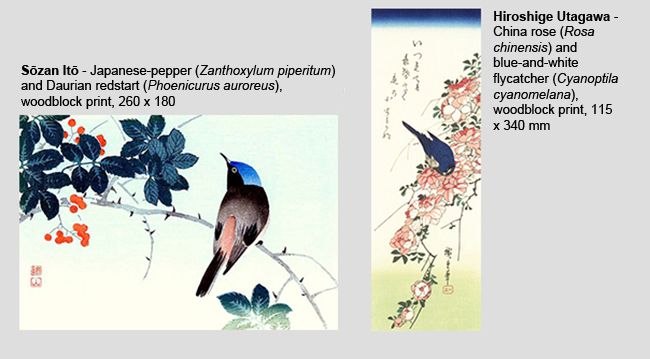Reader Collection > Blog > Picture Depth |
||
 |
||
| A picture drawn on paper has a length and a width but no depth. To create the illusion of depth western artists (e.g., European, American) often adjust the size of objects in a picture. If objects of equal size are viewed from different distances, the closer object appears to be larger. By adjusting the size of objects the artist can make one object appear to be further away than another. Some Japanese artists who drew pictures of flowers and (or) birds used this western technique to create picture depth while other artists did not. In the pictures below, chosen from the Reader Collection of Japanese Flower-and-Bird Art, the artist Sōzan Itō used this technique while the artist Taito II Katsushika did not. | ||
 |
||
| In Sōzan's picture the seven white-fronted geese differ in size which creates the illusion that some are closer to the picture viewer than others. In Taito II's picture the two mandarin ducks are about the same size even though the upper duck is supposed to be the background and the lower duck is supposed to be in the foreground. Taito II followed the Chinese practice of placing objects that are closest to the picture viewer at the bottom of the picture and objects that are furthest away at the top of the picture. The size of objects located at different distances from the picture viewer was not necessarily adjusted as it was in western art. Taito II's picture was drawn in the early 1800s when most Japanese artists used a style that was strongly influenced by Chinese art practices. In contrast, Sōzan's picture was drawn in the early 1900s when western art practices had replaced those of China as the major foreign influence on Japanese artists. A second method commonly used by artists to create the illusion of picture depth is to overlap objects. When objects overlap the shape of the closer object is seen completely while the shape of the more distant object is partly hidden. By partly hiding the shape of one object behind another in a picture it appears to be further away to the picture viewer. Both western and Chinese artists used this technique so it was also adopted by Japanese artists regardless of whether they were influenced by western or Chinese art. However, because object size was less important than its position in Chinese art the size of the partly hidden object was not necessarily reduced to indicate that it was in the background. As a result, the sizes of the same two overlapping objects may differ in Japanese art, depending on whether the artist was influenced more by western or Chinese art. One example is shown below. |
||
 |
||
| In both pictures chrysanthemum plants are partly hidden by domestic fowl which indicates that fowl are in the foreground and chrysanthemums are in the background. However, the size of the chrysanthemum plants and their flowers in particular, are much larger in the picture drawn by Satarō Nagao than in the picture drawn by Sōzan Itō. The relative sizes of the fowl and chrysanthemum are less true-to-life in the picture drawn by Satarō whose drawing style was more similar to that of Chinese artists than western artists. A third technique used to create the illusion of depth in a picture is to apply color unevenly rather than evenly. Color becomes less intense as distance from the viewer increases so, for example, adding an unevenly colored sky to a picture gives it depth. Japanese artists influenced by western art used this technique more often than Japanese artists influenced by Chinese art. The two pictures below provide an example of this difference between pictures drawn by western-influenced and Chinese-influenced artists. |
||
 |
||
In the picture drawn by Sōzan Itō the sky's blue color gradually fades to white to suggest the distant horizon at the bottom of the picture. In contrast, the blue color at the top of the picture by Hiroshige Utagawa changes quickly to white which gives the picture much less depth. Hiroshige was active during the early 1800s and, like most of his contemporaries, was influenced by Chinese rather than western art. |
||
Additional Reading |
||